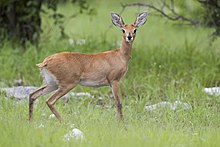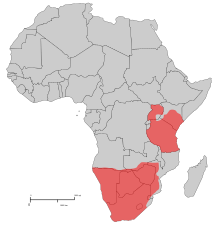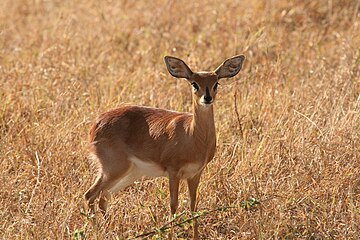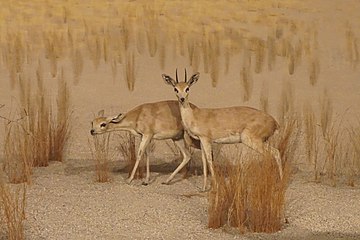Steenbok
| Steenbok | |
|---|---|

| |

| |
| Male and female in Etosha N. P. | |
| Scientific classification | |
| Domain: | Eukaryota |
| Kingdom: | Animalia |
| Phylum: | Chordata |
| Class: | Mammalia |
| Order: | Artiodactyla |
| Family: | Bovidae |
| Subfamily: | Antilopinae |
| Genus: | Raphicerus |
| Species: | R. campestris
|
| Binomial name | |
| Raphicerus campestris Thunberg, 1811
| |

| |
Distribution based on 1970s data.[2] | |
The steenbok /ˈsteɪnbɒk, ˈstiːn-/[a] (Raphicerus campestris) is a common small antelope of southern and eastern Africa. It is sometimes known as the steinbuck or steinbok.
Description
Steenbok resemble small oribi, standing 45–60 cm (16"–24") at the shoulder, and weigh 7-16 kg. Their coat is any shade from fawn to rufous, typically rather orange. The underside, including chin and throat, is white, as is the ring around the eye. Ears are large with "finger-marks" on the inside. Males have straight, smooth, parallel horns 7–19 cm long (see image left). There is a black crescent-shape between the ears, a long black bridge to the glossy black nose, and a black circular scent-gland in front of the eye. The tail is not usually visible, being only 4–6 cm long.
Distribution
There are two distinct clusters in steenbok distribution. In East Africa, it occurs in central and southern Kenya and northern Tanzania. It was formerly widespread in Uganda,[2] but is now almost certainly extinct there. In Southern Africa, it occurs in Angola, Namibia, South Africa, Eswatini, Botswana, Mozambique, Zambia, Zimbabwe and probably Lesotho.
Habitat
Steenbok live in a variety of
Population density is typically 0.3–1.0 individuals per square kilometre, reaching 4 per km2 in optimal habitats.[7]
Diet
Steenbok typically
Behaviour
Steenbok are active during the day and the night; however, during hotter periods, they rest under shade during the heat of the day. The time spent feeding at night increases in the dry season.[9] While resting, they may be busy grooming, ruminating or taking brief spells of sleep.[10]
Anti-predator

At the first sign of trouble, steenbok typically lie low in the vegetation. If a predator or perceived threat comes closer, a steenbok will leap away and follow a zigzag route to try to shake off the pursuer. Escaping steenbok frequently stop to look back, and flight is alternated with prostration during extended pursuit. They are known to take refuge in the burrows of
.Breeding
Steenbok are typically solitary, except for when a pair come together to
Breeding occurs throughout the year, although more fawns are born November to December in the southern spring–summer; some females may breed twice a year.
Steenbok are known to live for 7 years or more.
Taxonomy
Two
Gallery
-
Female in South Africa
-
Backlit male showing white fur in ears, Tswalu Kalahari Res.
-
Female running in Damaraland, Namibia
-
Steenbok in the Savanna Bush diorama at the Milwaukee Public Museum
Notes
References
- . Retrieved 12 November 2021.
- ^ ISBN 0-00-219294-2)
- ISBN 0-550-10105-5.
- PMID 11420362. Retrieved 2007-06-17.
- ^ ISBN 0-12-408355-2)
- ^ .
- ^ Kleiman, David G. et al., Eds. 2003. Grzimek's Animal Life Encyclopedia, 2nd edn. Vol. 16: Mammals V. Gale Cengage Learning. Pp. 59–72.
- .
- ISBN 1868725502.
- ^ a b Cohen, Michael. 1976. The Steenbok: A neglected species. Custos (April 1976): 23–26.
- OCLC 62265494.





